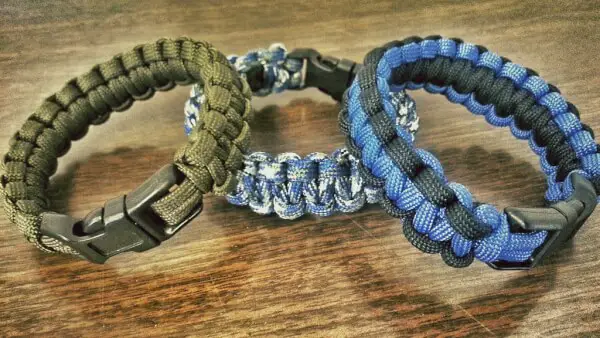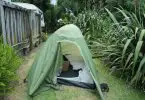Surviving outdoors can be a big challenge for some people and you might not be an exception to the rule.
Therefore, having the right tools is necessary if you want to remove the stress of having to do without some of the basic necessities of life while you are outside and this is where paracord bracelet instructions enter the picture.
The bracelets are a neat fit for going camping, hunting wilderness activity or indulging in any other outdoor activities and you might just want to know how to make them for yourself or someone else. Our article on how to make paracord crafts to help in any wilderness camping so check it out.
Why Use Paracord to Make The Bracelets?
Paracord is a strong and durable material that can keep the bracelet in place and prevent it from falling apart. Its use has been dated as far back to World War II when US parachute manufacturers depend on it to keep the chutes suspension line from breaking. The cord’s minimum breaking strength in the bracelet is equal to about 550Ib (250kg).
Start Making Your Paracord Bracelet
Here are some simple survival bracelet instructions steps to follow when making your bracelets using paracord:
Gather the things you will need
To make the job simpler, you should first gather everything you will need so that you can complete your task quickly.
Items you will need are:
- A single color paracord measuring about 5 feet (1.5m)
- Another 5ft (1.5) of paracord in a different color of your choice
- Lighter
- Scissors
- 2 ½ feet (75cm) of paracord in a third color
- Needle and thread (optional)
- Crazy glue
If you like, you can choose to use another type of cord, but frankly paracord is most convenient to use and the cost is reasonable. Now to the next step…
Choose the size bracelet you want
If you are making the bracelets with the intention of selling them, then you are free to make them in all different sizes. However, if making them for you or a friend then size matters.
Therefore, before starting your journey in making the bracelet, make sure to take a careful measurement of you or the person’s wrist you are making the item for.
Once you have your size in mind, it is now time for you to start making your bracelet. The first thing you will have to do is gather enough paracord and double it. The length should reach about 2 ½ feet. You should follow through by measuring an inch or two of the cord and then tying a simple knot at each loose end.
To not make the item too small or large, you should make sure to check to see if the size bracelet you are making is correct and you can do so by placing the loop over the knotted part of the cord. For the bracelet to not fit on the wrist too tight, you should make it slightly loose.
If you are worried about how loose the bracelet will become, there is no need to because once you complete the job, the band will start getting fatter and thus fit your wrist better.
In addition, even if you do not get the exact size, you can always fine-tune the band later at your own convenience. Furthermore, if you see the knot showing any loose ends, you can use your scissors to trim them off.
Bringing the two paracords together
Find the two tallest pieces of the paracord and pull out the inside strings of one of them. You must then cut off the strings with the scissors and push the other cord into the vacant spot of the one you removed the strings from, thus, bringing them together.
- Tighten the bond. You then have to make the bond tighter by sealing it with a little tip of crazy glue or putting in a few stitches with a needle and thread.
- Remove scratchy edges. If scratchy edges are showing as well as for comfort on your hand, you can use a cigarette lighter to melt them down. At this time you should not be too concerned about how neat your join looks because the inner part of the bracelet will hide it.
- Tie a rock-climbing knot. Since the join might still not be strong enough, you should use a rock-climbing knot to hold them together. If you are a beginner bracelet maker and do not know how to make a rock-climbing knot, then you should follow the following instructions:
- Use the end of the rope to make the figure eight. Then go ahead and push the tail straight through the harness.
- Do a re-rinse of the numeral eight exactly like the first one. Your next task is for you to tighten the knot; however, make sure that you will not come up short on tail rope since the knot has way of slipping after being loaded.
- Make sure to check the knots. To check the knots, start counting the visible strands. When counting the strands, you should get “two”, and “two”.
- Once you are satisfied with the strands count, ensure that each strand is lying flat on thier face and not crisscrossing one another.
Get your cobra stitch (also called Solomon bar or Portuguese sinnet) going
See a few YouTube videos below that can help you make a cobra knot:
This second video teaches you how to make a cobra stitch with a buckle.
The cobra stitch/knot is also widely called the Solomon bar or Portuguese sinnet. It is a knot that is dated as far back during World War II.
In the past, military personnel often depended on it to create a snap shackle pull. Once the process of making the knot is completed, it can be used as Girth Hitch with an attachment to the pull-ring.
To get your cobra stitch, you have to place the paracord pieces to resemble a “T” sign. The shorter piece join should be placed in front of the longer piece with the longer piece sitting directly underneath the shorter one.
At this time you can start making your cobra stitch. To make your cobra stitch, take the right “T” arm and place it on the left side. Then push the left strand through the loop that is on the right.
Start tightening the knot but make sure to leave approximately 1 inch (2.5cm) length of loop at the top. For a stable bracelet, make sure to tie your knots firm but not too tightly that it will leave stretch marks on your hand.
When you are through making your first cobra stitch, you should make a second one just like your first one. Continue making more cobra stitches and placing them on the other sides. At this time, your work should be showing one color paracord at the top and the other color tucked behind as well as visible through the loop.
For stronger cobra stitches, hold the overhand knot seen at the bracelet’s bottom and place the stitches closer together while placing some pressure on the cobra stitches by pushing them upward toward the top of the loop. To keep the loop from sliding at the top you can place a ruler through it.
In the meantime, you should keep adding more cobra stitches until you reach approximately 1/2 inch of the bottom of the granny knot. For more tips on how to make the basic paracord knots, check out our earlier article for details.
Now you can try your newly made bracelet on your wrist to see if it is a good fit. If it is tight or too loose, you can adjust the overhead knot’s position to get the right fit. For easier removal from the wrist, some bracelets carry a side release buckle. If your bracelet has no side release buckle then it should have a double knot at the end to keep it securely on your wrist.
How to Make Your Paracord Bracelet with A Buckle
The above instructions teach you how to make a non-buckle bracelet. Now here is how you make a buckle bracelet using paracord.
If you rather a bracelet with a side release buckle, you will have to have more materials on hand. You can buy a side release buckle at your nearest equipment store.
As a beginner, you will have to still use two different colors of paracord joined together just like you are making the item without a buckle. Apart from gathering your materials, you should also choose your colors and the size bracelet you desire to make. Keep to the same rule as making a bracelet without buckle.
- First you need to have your paracord folded in half. Then you must choose a buckle half and push both ends through it. When you are about to reach the other end of the paracord, create a loop and secure the buckle by pushing the ends through the loop.
- Your next step is to find the free ends and push them through the remaining half of the buckle. You do not want to make the bracelet too big or too small so at this time it is best that you measure it on your wrist before continuing the process.
- Your next task is for you to use the ends that you already slip through the other half so that you can get your cobra knot going. Continue this procedure until you are at the end. Always keep in mind that you need to tighten everything up as you proceed.
- As it is, there should be some extra paracord remaining. Cut any remaining paracord and burn away rough ends with the lighter so that the paracord remain stable and not consist of any weak links that might soon start falling apart. Stick the ends into the braiding and yippee, you have your paracord bracelet with the side release buckle.
Other Patterns You Can Use
As a beginner, the cobra knot is easier and convenient for you to use.
However, if you want a bit more challenge you can go for other type patterns such as the:
- Fishtail weaving
- Ladder rack
- Corkscrew design
- Snake designs such as the king cobra, viper, sidewinder, boa, copper head and mamba
- Saw tooth
- Wide dragons tongue
- Center stitched
- Trilobite
Presently, many designs are out there and every now and again someone else creates a new design on the market.
Uses of Paracord Bracelet When You Are Out Camping In The Wilderness
- Make traps to catch small animals for food: Paracord makes it easier for you to trap your food when you are in the wilderness. In addition, by making a trip wire with the bracelet and placing it at a hidden position, you can have heads-up early warning that someone or something is approaching your campsite.
- Make a bow and arrow weapon: If you are in the wilderness and find yourself without the right hunting tools, you can use your paracord to make a bow and arrow weapon and kill small animals with it.
However, to make such a weapon, you will have to include other things such as feathers, flexible saplings and tree shoots. Locate the right kind of wood and use the paracord to make the bowstring. Use the strand from another available paracord to cause the arrows to hold the feathers and thus you have a good hunting weapon. - Use it to build your tent: You can combine your paracord with a tarp to build a tent while you are in the wilderness. All you have to do is to use the paracord to tie the tarp to a tree and you can enjoy the comfort as well as protection of your new wilderness home.
- Use it to help make a splint: If you should get a broken leg from a slip or fall while you are enjoying the wilderness, chances are there are no medical facilities nearby for you to get treatment.
Therefore, you will have to use a man-made splint made from stiff branches and so on. You can use your paracord to tighten the splint so that the bone in your leg can set back. - Use it to replace shoelaces, suspenders, and belts: Your paracord bracelet can be used to replace lost or ripped shoe laces and suspenders as well as your belts. In addition, if your bag pack needs some extra reinforcing, you can always depend on your paracord bracelet to provide additional stability.
Although many people wear paracord bracelets for fashion purposes, it is a handy tool to have in your possession most times as it can save your life while you are outdoors. We’ve also written a whole article on the uses for paracord bracelets.
If you should find yourself in a life and death scenario while camping in the wild, your paracord bracelet is a nice friend to call up on. For more camping hacks to help you survive in the wilds, see our earlier piece on this important topic.
It is easy to carry around on your person because all you have to do is to wear it on your hand. It is a good habit to pick up when you wear a paracord bracelet to safe-guard your life while out in the wild.
Featured Image Source: https://www.flickr.com/photos/29053927@N05/9721202956







